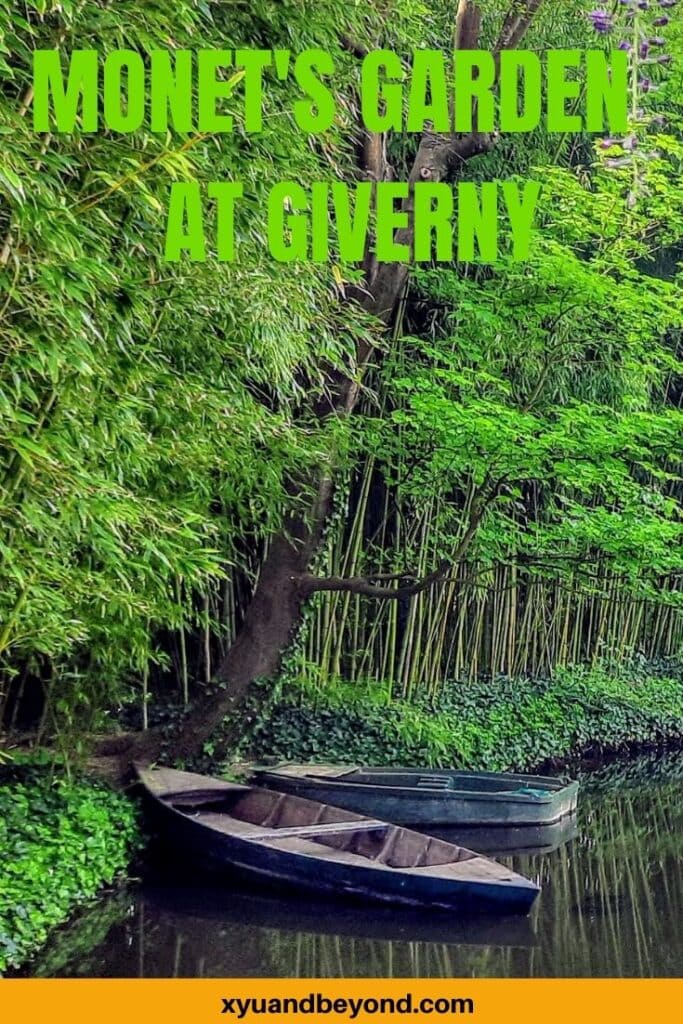Visiting the Captivating Claude Monet Garden at Giverny Normandy
Visiting Monet’s garden France at Giverny officially called the Fondation Claude Monet, in Normandy was a dream of mine for many years. His paintings of flowers, and lilies and his garden were and are an inspiration for both painters and gardeners and are one of the most visited sites in France. Monet spent most of his time at Giverny from 1883 until his death in 1926.
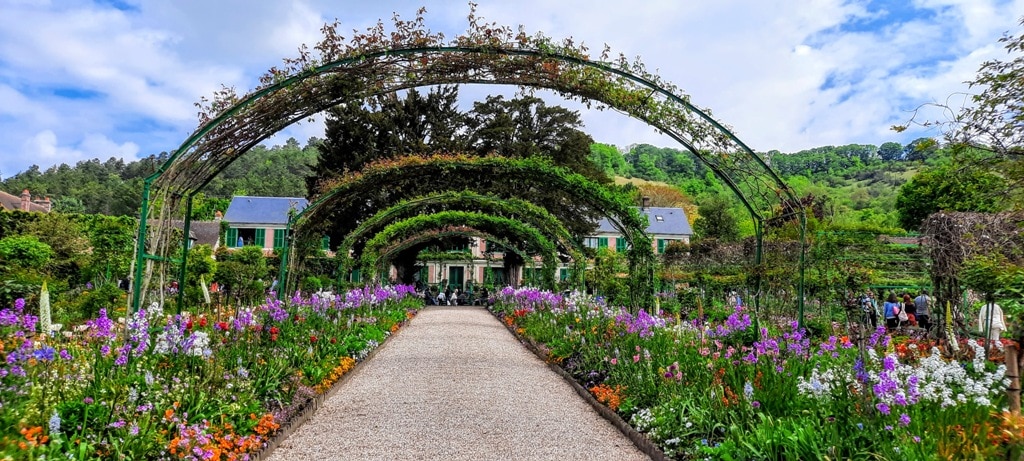
To visit Giverny which is probably the most famous garden in the world is flower overload. Giverny is managed by the Claude Monet Foundation, a non-profit organization and over 500 000 people visit every year and I think 100,000 of them were there on a beautiful May day when we visited. Talk about getting over-peopled.
Monet of course painted some of his most famous works while living at Giverny. The Water Lillies which is his biggest painting at 3’4” x 6’7”. Many of the works were painted while Monet suffered from cataracts On 19 June 2007, one of Monet’s Water Lily paintings sold for £18.5 million at a Sotheby’s auction in London. On 24 June 2008 another of his Water Lily paintings, Le Bassin Aux Nymphéas, sold for almost £41 million at Christie’s, many of the originals are in the Musée Marmottan Monet in Paris.

- Visiting the Captivating Claude Monet Garden at Giverny Normandy
Xyuandbeyond is reader-supported. When you buy through links on our site, we may earn an affiliate commission. You can read my privacy policy here.
Monet’s garden from Paris
In what french village is the artist Claude Monet buried? Monet’s garden is of course located in a tiny village called Giverny which can be found around 80km from Paris. If you rent a car it is a pretty easy hour’s journey from Paris to Giverny and there are 3 massive parking lots available that are free, but again get there early or space will be at a premium.

By train from Paris: take the ‘Grande Lignes’ from Saint Lazare train station in Paris to Vernon which by the way is a lovely city to visit. When you get off at Vernon, follow the signs to the shuttle bus that will take you to Giverny.
From Spring to Autumn a bus shuttle links Vernon-Giverny train station and the central bus station in Giverny’s main parking lot. A daily round-trip fare is 10 euros.
To get to Giverny is not that easy to reach by public transportation as there is no direct route unless driving, I highly recommend taking a guided tour from Paris.
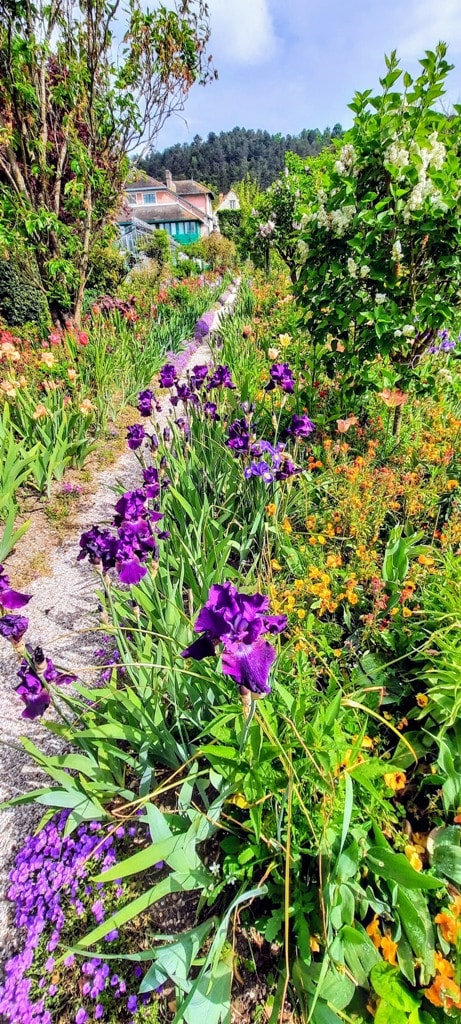
Best time to visit Giverny
Monet’s garden and house are open from March 28th to November 1st from 9:30 am to 6 pm. The best time to visit is during May and June when the garden is in full bloom. Avoid statutory holidays and weekends the crowds get pretty huge then.
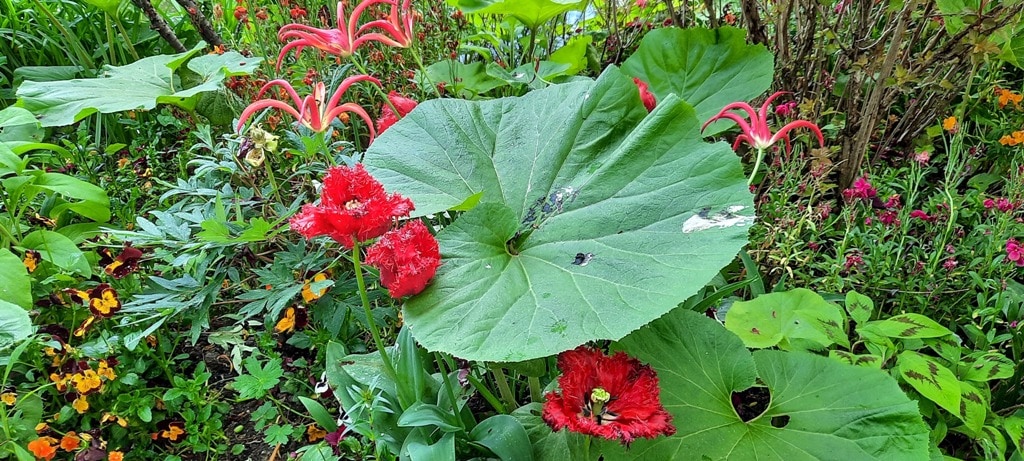
Giverny Garden Tickets
Book your tickets in advance to avoid the massive line-ups for ticket purchases at the gate. Tickets for adults cost between €13.00 and 13.45 depending on which ticket seller you buy from.
Exploring the Monet House and Garden
There are two parts to Monet’s garden when you enter the garden you will initially spot a small staircase that leads to the water gardens across the road from the main house and then the main house and flower gardens in front lead off to the left of the entry.
There are directional signs but usually, you can’t see them for all the crowds of people.

Tips for visit to the Monet Garden
- Go in April or May if you can and go early as you can get the first tickets. The place is swarmed no matter what time of year you go and if you can’t deal with crowds you won’t be able to avoid them here.
- Book your tickets in advance to beat the huge lineups that usually take place.
- Wear comfortable shoes for lots of walking, wear sunscreen and bring a bottle of water. There are benches around to rest on if you tire of walking for a while the best ones are located by the ponds.
- Seriously the biggest tip for visiting Monet’s Garden I can give you is to head to the ponds across the road first. You won’t avoid the crowds but you will avoid having to head back through the main gardens and the house through to the gift shop and out of the exit in the gift shop.
Map of Monet’s Garden
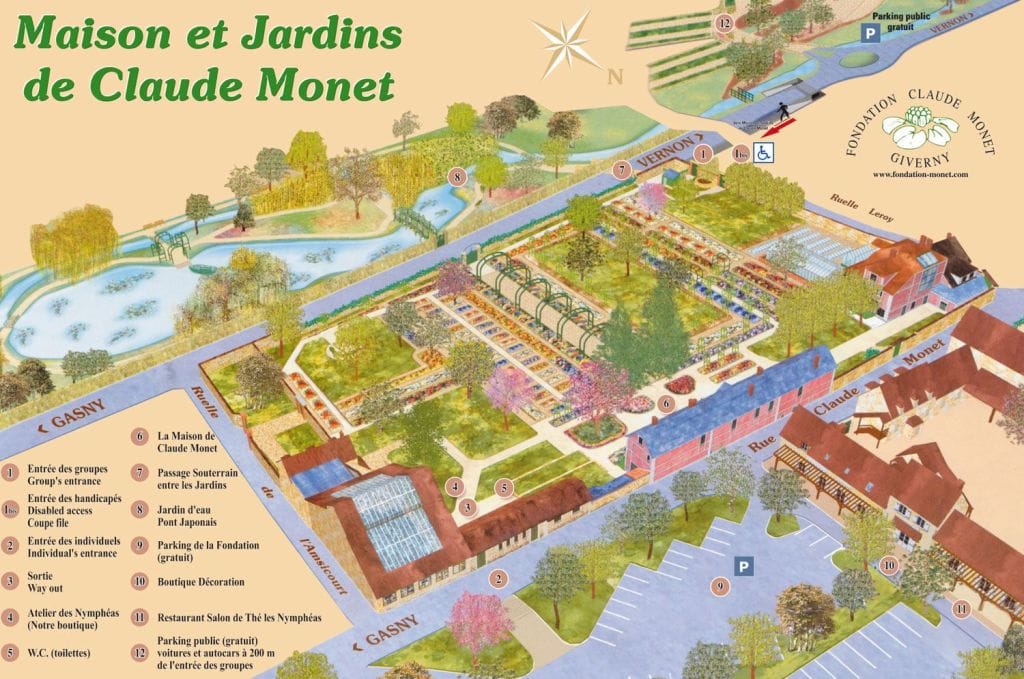
The Water Garden and Lily Ponds
As I mentioned I would suggest if you have walking issues or it is a very hot day to make your visit more enjoyable head to the Water gardens first. These gardens are beautifully shaded with bamboo and other trees and have a Japanese theme with the iconic Japanese bridge over the pond covered in wisteria.
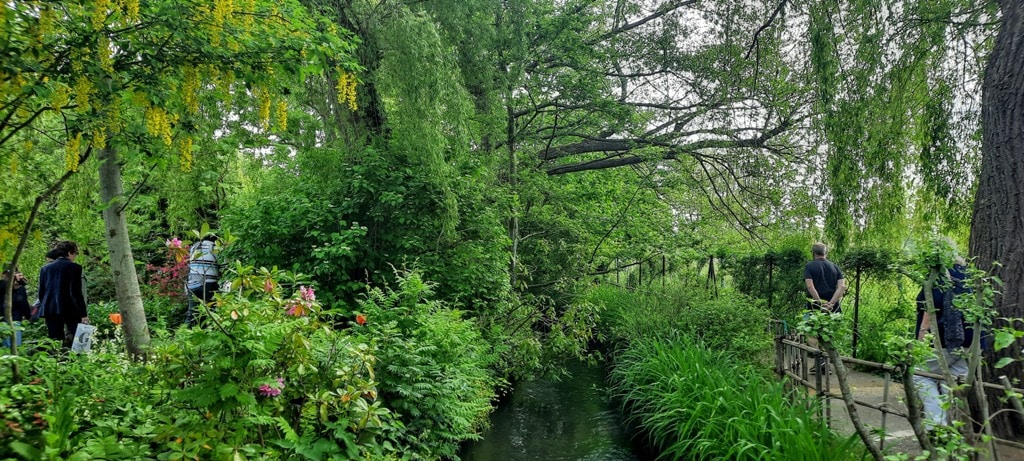
Monet lived at Giverny for 10 years before he purchased the land from his neighbours across the road. It was crossed by a small brook, the Ru, which is a diversion of the Epte, a tributary of the Seine River. The neighbours (as some neighbours do) complained because they were afraid his strange plants would poison the water but fortunately, Monet ignored them and continued to expand his ponds and gardens over the land.
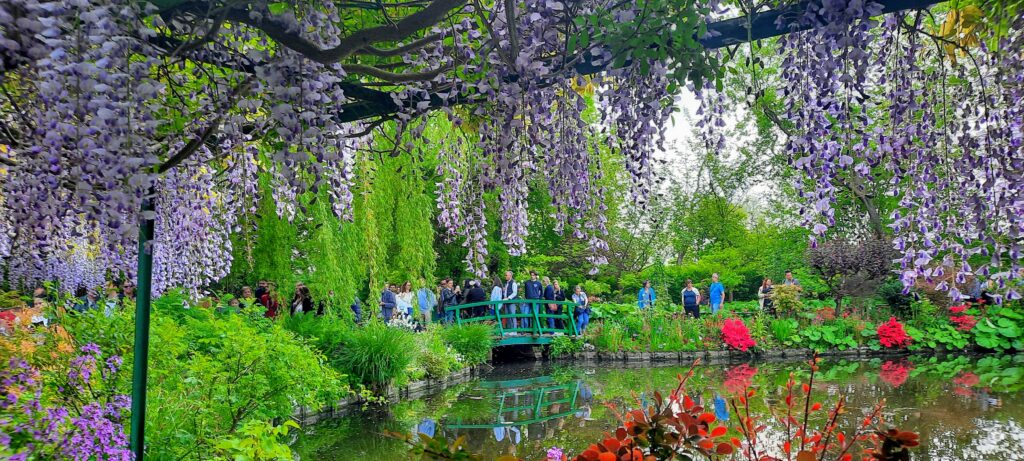
Japanese gardens inspired Monet and when you visit the house you will see a collection of Japanese prints that were part of that inspiration.
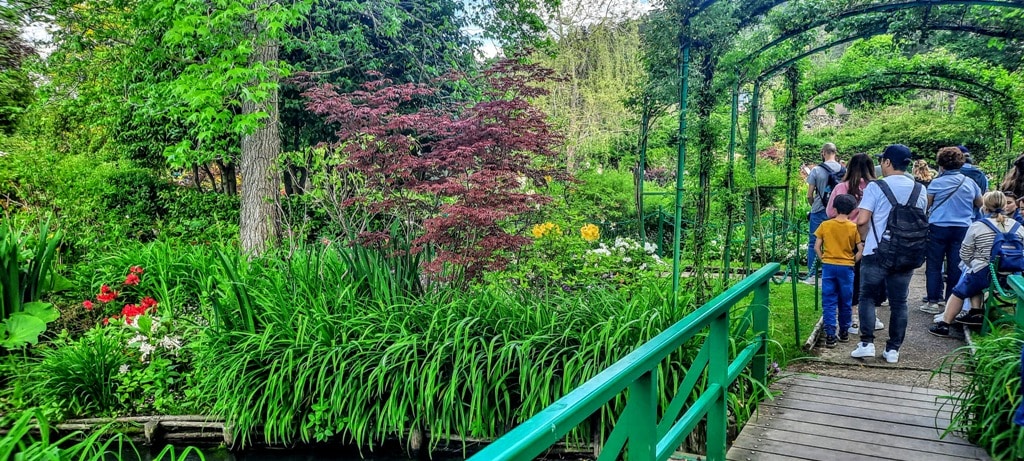
These gardens are somewhat shaded with massive stands of bamboo and other trees all growing with amazing colourful flowers. The narrow paths have benches where you can sit, breath and enjoy the views. Eventually, the paths will lead you to his famous Japanese bridges of which there are two small ones and then the larger famous bridge that features in his paintings.
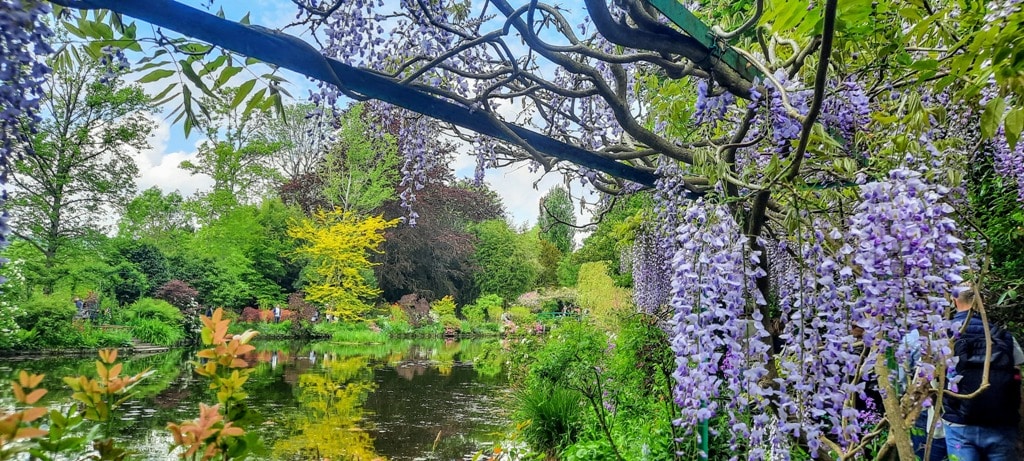
The edges of the ponds have stunning plantings including weeping willows, cherry trees, Japanese maples, ferns, irises, wisteria, azaleas and many more.
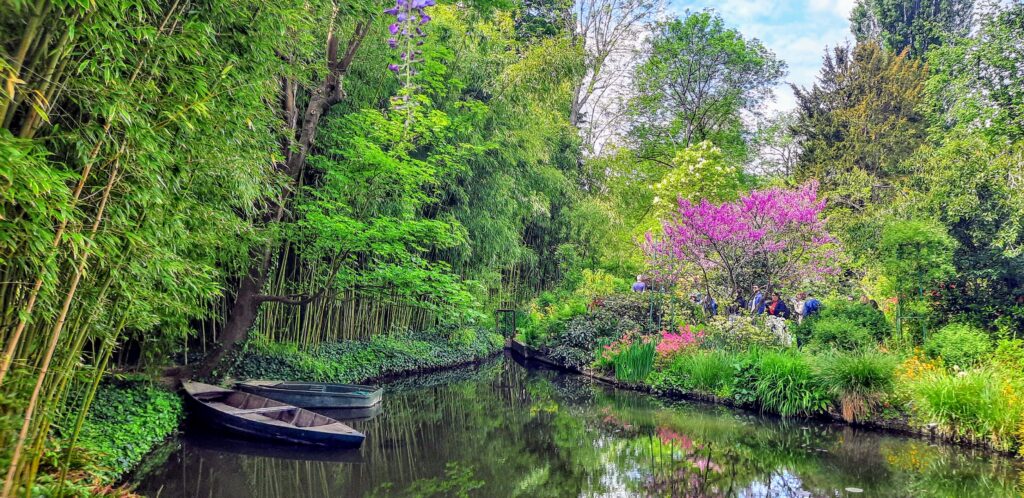
However, if you hope to see the water lilies you need to visit in July or August. You won’t ever get a clear shot of the famous bridge without any people on it though so be prepared.
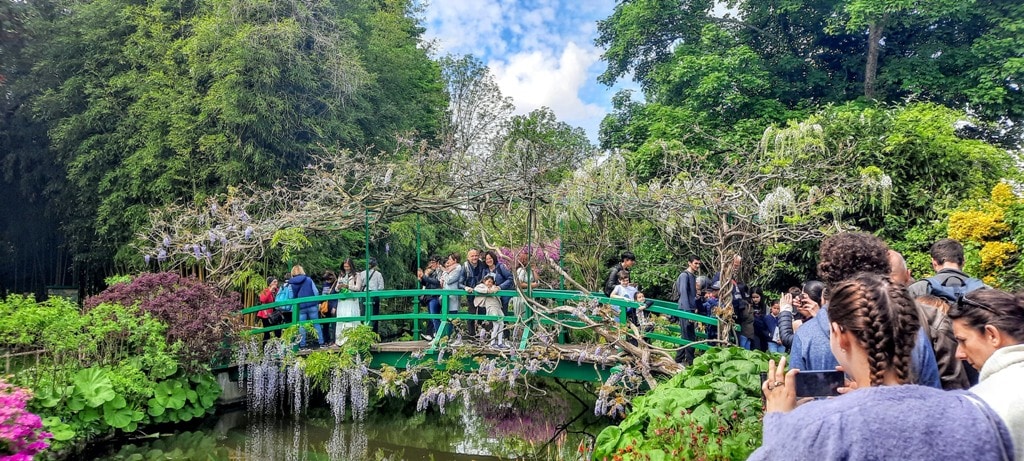
The Flower Gardens – The Clos Normand
When you cross back over the road to Monet’s flower gardens they are laid out in colour-themed borders. There are thousands of plants in colours I’ve never seen before. Mouthwatering reds, pinks, blues, purples, greens, oranges, and yellows.

You can’t even begin to describe the lusciousness of these gardens. Full of tulips, irises, poppies, peonies, alliums, and so many plants. Made me wish I was a better gardener.
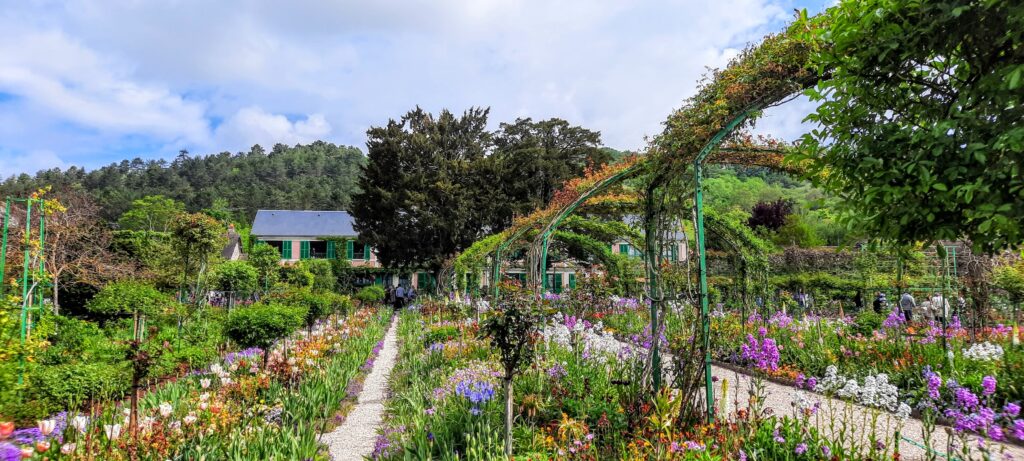
You will of course immediately spot the famous arches or the Grand Allee that lead up to the house and then the house with its famous green shutters and gardens of pink tulips in front. Clambering over the walls of the garden are nasturtiums, ivy, and Virginia creeper and the gardens are laid out in colour spectrums.
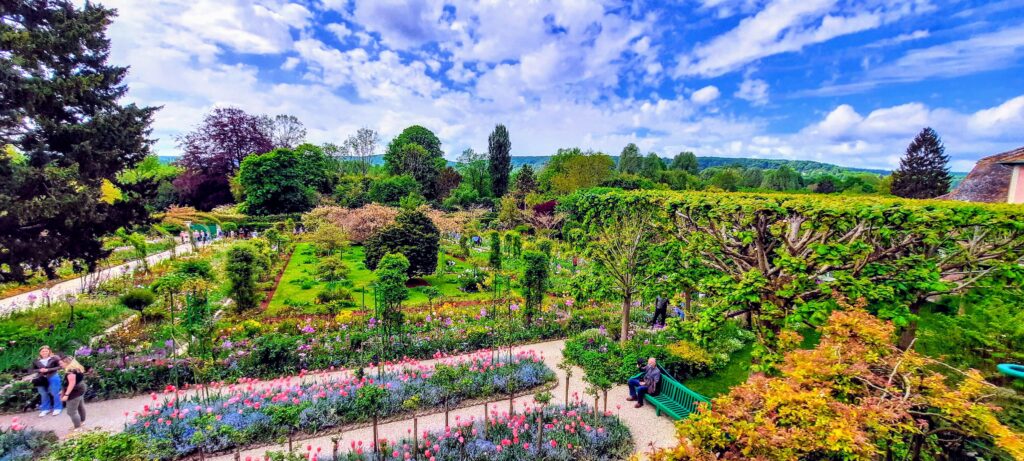
The garden is laid out in straight lines with lots of long beds with walkways between them and then some large areas of grass and trees. It is a simple garden design obviously with a painter’s eye.

Monet’s House
The house itself faces the road and it is built in the local style with pink stucco walls and vibrant green shutters. The lineup to get into Monet’s house can be a long one but it tends to move pretty fast. It is a simple structure with a lovely veranda stretching across the front and of course that gorgeous green colour of the shutters.
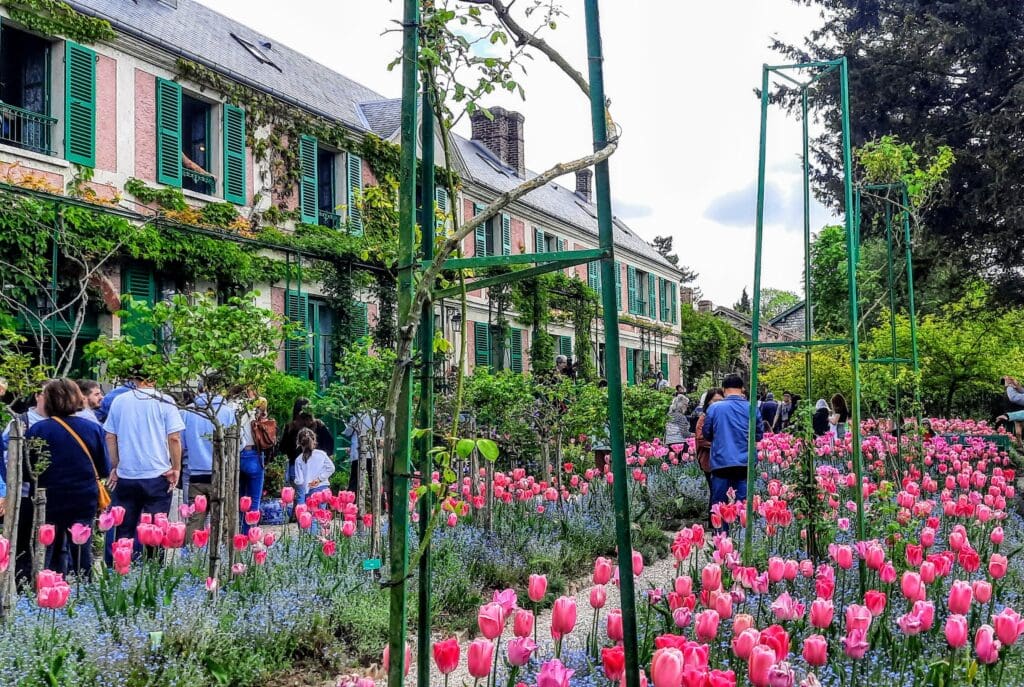
The first room you enter is the Reading room also called the Little Blue Sitting room. The room is decorated with Monet’s works and was his first studio where he worked until 1899. Later it was changed to a sitting room when he built a larger studio.

From there you head upstairs to the private apartments including Monet’s bedroom and through to dressings rooms and Alice’s bedroom.
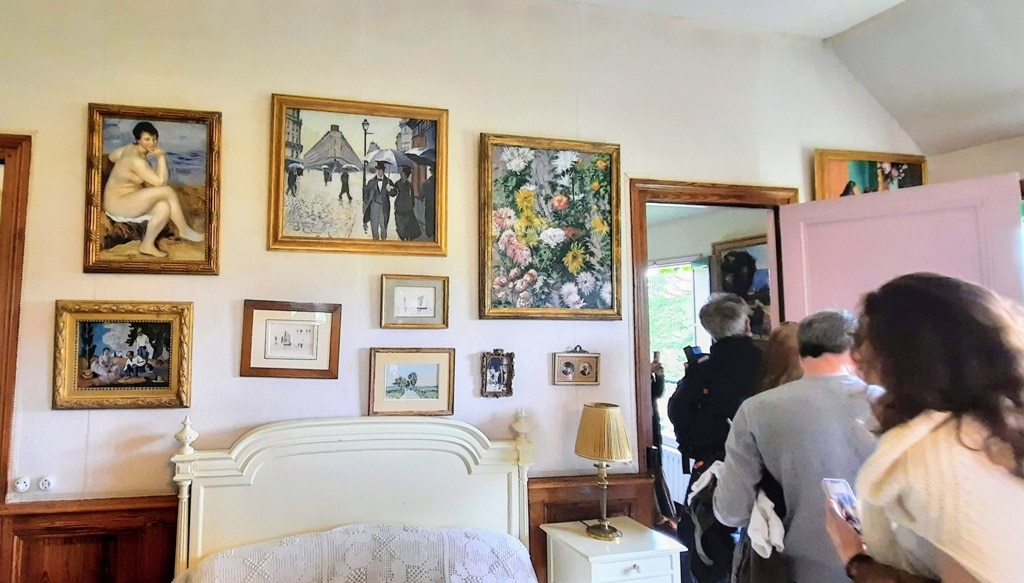
Finally, the last room on that floor, Blanche Hoschedé-Monet’s bedroom was opened to the public for the first time in 2014.
Blanche was the daughter of Monet’s second wife and she also married his son Jean. Blanche was also a painter.

After visiting upstairs you will then come down into the dining room and kitchen. In the dining room, there is a collection of Japanese prints on the wall and a lovely butter-yellow table and cabinets. In the cabinets are the blue earthenware dishes that were used by Monet for special occasions.

From here you head through to the famous blue and white tiled kitchen with it hanging copper pots and Rouen tiles looking like the owner just stepped outside to the garden.

Places to visit near Giverny
Musée des Impressionnismes Giverny
As you exit Monet’s gardens – through the gift shop which is in the far right corner of the property you can walk down the path to the village. Walking through the village you can explore Giverny the Musée des Impressionnismes Giverny.

Which presents several exhibits but no Monet originals. In nearby Vernon a small city you can find the Musée A G Poulain which contains the only Monet original in the Giverny area. Many more can be seen at the Musee Marmottan Monet in Paris.
Hôtel Baudy
When Monet was alive, artists including the likes of Cézanne and Rodin poured into Giverny to get close to the Master of Impressionism. Many stayed at this boarding house, which became a place frequented by artistic legends. The Ancien Hôtel Baudy is now a café and restaurant.
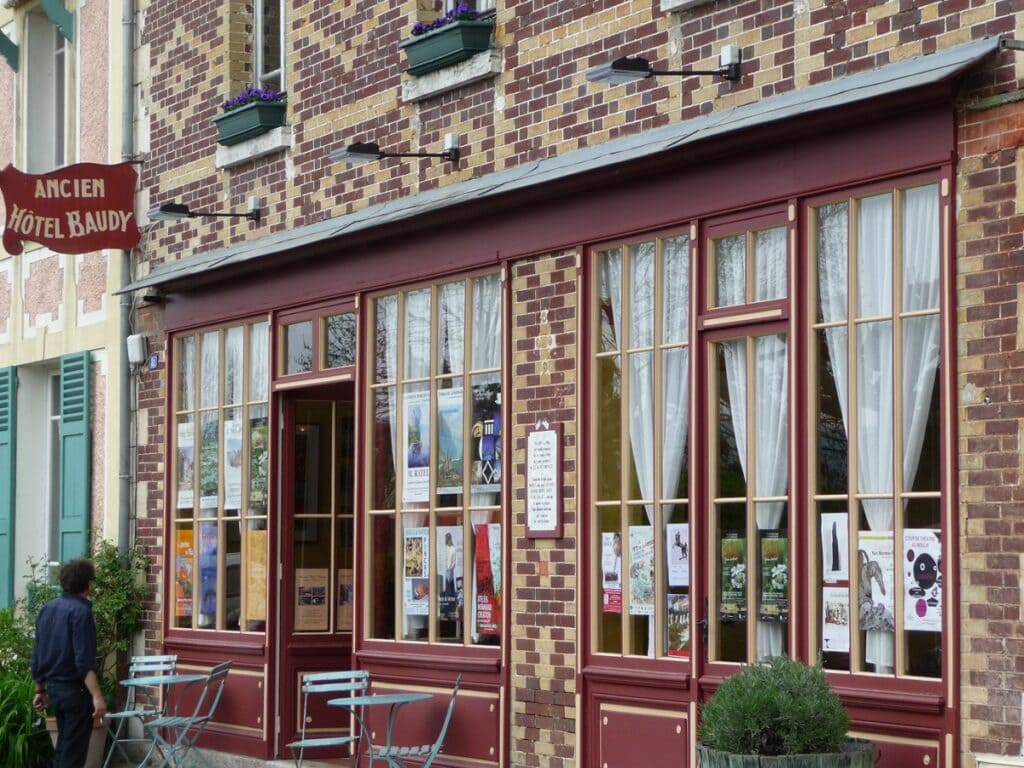
Church of Sainte-Radegonde de Giverny
Head up the main street in Giverny, Rue Claude Monet, and in ten minutes you’ll reach the 16th-century church that Monet attended and where he and his family are buried. The Monet family grave is behind the church, a white marble structure topped by a cross, and Claude Monet’s tombstone is at the front.
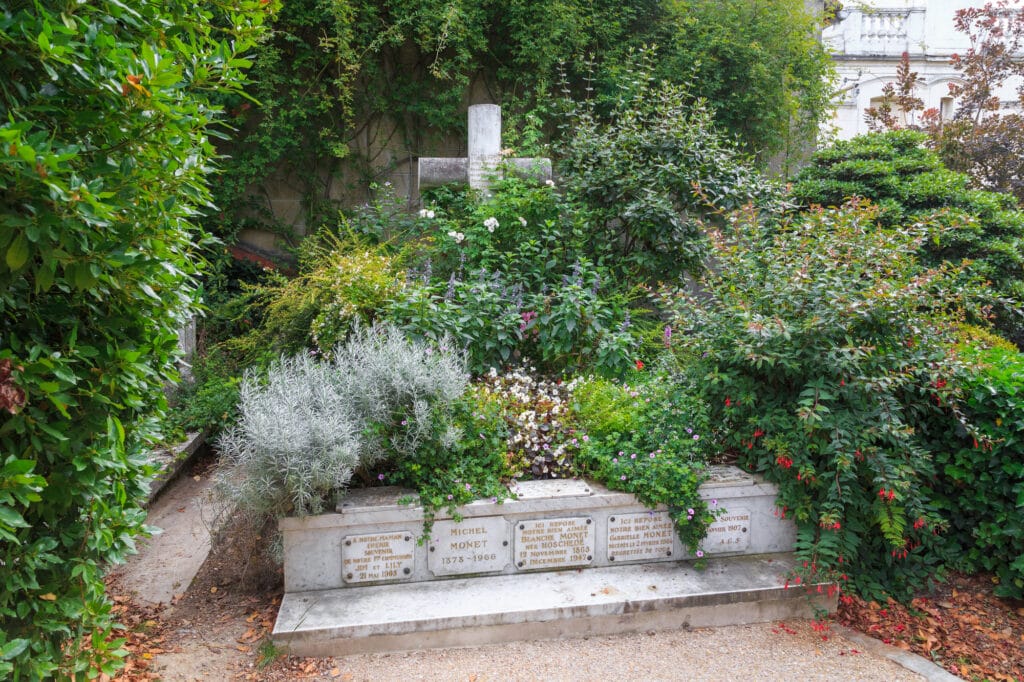
Tours of Monet’s Garden & Giverny from Paris
Giverny Monet’s House and Gardens Skip-the-Line Ticket with small Group: Delve into the creative mind of impressionist master Claude Monet on this small-group Giverny day trip from Paris, including round-trip transport and admission tickets. Explore the artist’s former home and gardens independently, where you can peek into his studio and bedroom, and stroll through the colourful gardens, which inspired many of his paintings. Next, pay a visit to the Museum of Impressionism (extra cost), visit Monet’s grave or stroll through the village of Giverny, where you find many cafes and souvenir shops.
Read more about Giverny Monet s House and Gardens Skip-the-Line Ticket with small Group

Giverny Monet’s Garden & Auvers-sur-Oise with Van Gogh House Full Day From Paris: Immerse yourself in French Impressionism on a full-day art history tour through Giverny and Auvers-sur-Oise. In addition to navigating, your guide offers anecdotes often unheard by visitors about the lives of renowned French painters Monet and Van Gogh. Stops on the itinerary include Monet’s home and flower garden and Van Gogh’s boarding house and tomb. With a group capped at 8 people, this tour provides an intimate experience.
Read more about Giverny Monet’s Garden & Auvers-sur-Oise with Van Gogh House Full Day From Paris
Monet’s Gardens & House with Art Historian: Private Giverny Tour from Paris: Discover the stunning gardens of Giverny during this half-day, art-historian led VIP tour. See where the French Impressionist Claude Monet lived and painted for 43 years, and visit the neighbouring village for a peek at quaint flower-covered cafes, boutiques, and galleries. Tours include priority admission tickets and luxury, door-to-door vehicle transfers from Paris.
Read more about Monet’s Gardens & House with Art Historian: Private Giverny Tour from Paris
Vernon and its old mill
Floods of tourists heading for Giverny pass through the pretty historic town of Vernon on the banks of the River Seine.
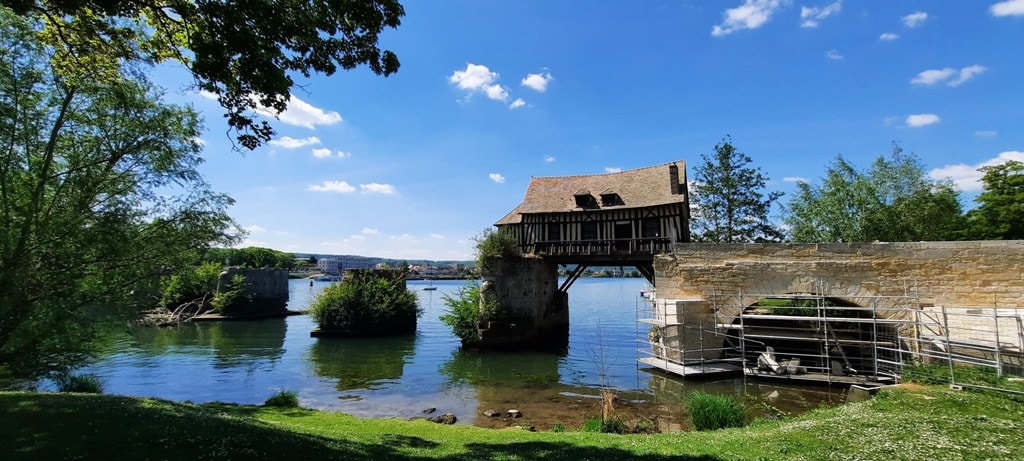
Vernon boasts a particularly picturesque old mill, and its fine arts museum, the Musée de Vernon, holds some interesting pieces including a few lesser-known paintings by Monet.

Where to stay near Giverny
You will find that accommodation near Giverny is quite expensive and very hard to come by so look for something in Vernon or the village of Saint Aquilin de Pacy where we stayed. The town centre of Pacy Sur Eure with its shops and restaurants is a 5-minute walk away.
I highly recommend Les Clos de la Tannerie which is a gorgeous gite right on the edge of the village. The cost is €115.00 per night with a minimum of 2 nights Within a former 400 sq. m (4,305 sq ft) tannery, a five-minute walk away from the town centre of Pacy Sur Eure, there are 3 beautiful holiday cottages, ranging from just a bedroom to a lovely gite which we stayed in.
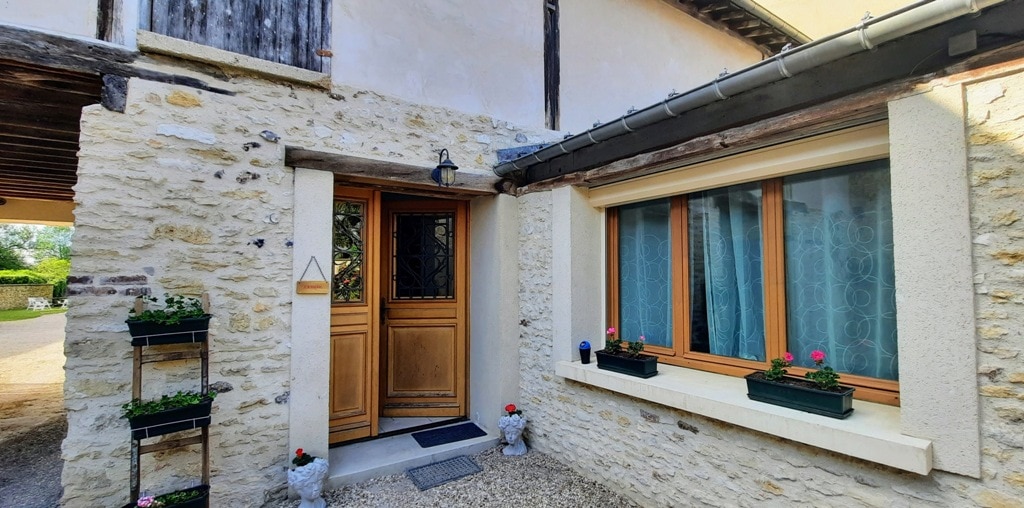
The gite has a stunning garden right by the river and you can enjoy the gorgeous garden and simply relax. You are within walking distance of the village and right across the road is a fabulous Moroccan restaurant where we enjoyed a brilliant tagine and couscous.
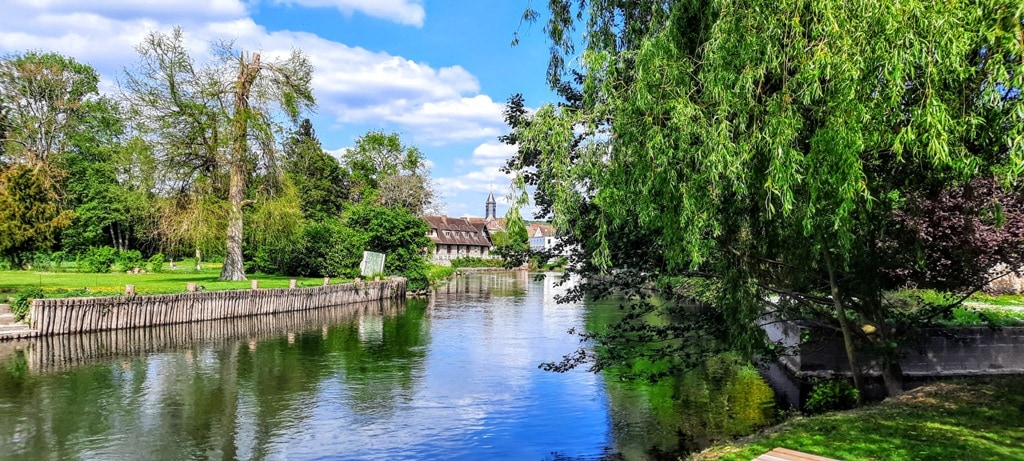
Visiting Monet’s Garden in Giverny was an incredible experience, despite the crowds of tourists. The riotous colour of the main gardens and the entrancing peacefulness of the water gardens might make a painter out of me yet.
You might also like
Beautiful villages in Normandy
Château de Josselin – A 1000 years of history in the heart of Brittany
Visiting Mont St Michel the ultimate guide to this UNESCO site
Castles of the Loire Valley France
Food in Brittany: Fall in love with the food of Bretagne
Exploring the beautiful Mayenne – Pays de la Loire, France
Where to find the sublime lavender fields of France
PIN IT TO SAVE IT
